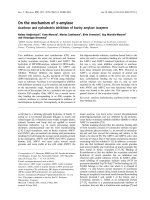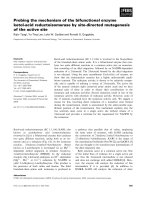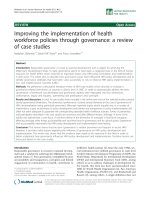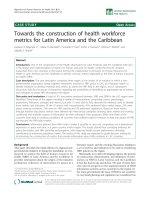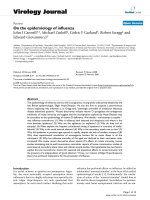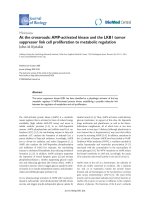Báo cáo sinh học: "Making the jump: new insights into the mechanism of trans-translation" pdf
Bạn đang xem bản rút gọn của tài liệu. Xem và tải ngay bản đầy đủ của tài liệu tại đây (195.36 KB, 4 trang )
Minireview
MMaakkiinngg tthhee jjuummpp:: nneeww iinnssiigghhttss iinnttoo tthhee mmeecchhaanniissmm ooff
ttrraannss
ttrraannssllaattiioonn
Jacek Wower*, Iwona K Wower* and Christian Zwieb
†
Addresses: *Department of Animal Sciences, Auburn University, Auburn, AL 36849, USA.
†
Department of Molecular Biology,
University of Texas Health Science Center at Tyler, 11937 US Highway 271, Tyler, TX 75708, USA.
Correspondence: Christian Zwieb. Email:
DDiissccoovveerryy aanndd pprrooppeerrttiieess ooff ttrraannssffeerr mmeesssseennggeerr RRNNAA
tmRNA was discovered in 1995 [1], when Simpson and co-
workers overexpressed a mouse cytokine in Escherichia coli
and found truncated cytokine peptides each tagged at the
carboxyl termini with the same 11-amino acid residue
extension AANDENYALAA. This tag sequence turned out to
be encoded in a small stable RNA that had been identified
many years earlier as a 10S RNA of unknown function [2].
The 10S RNA is now known as transfer messenger RNA
(tmRNA). As its name implies, tmRNA has features of both
transfer RNA and messenger RNA. One domain of the
molecule, known as the transfer RNA-like domain (TLD),
has an amino acid acceptor stem chargeable with alanine
and a T arm with modified nucleotides, just as in tRNA
(Figure 1). However, the D arm of the tRNA-like domain is
degenerated, and there is no anticodon loop. A second
domain, the mRNA-like domain (MLD), is located in a
pseudoknot-rich region and contains a short open reading
frame that encodes AANDENYALAA and is followed by a
normal stop codon. It was quickly established that this
peptide targets the truncated ribosomal product for
degradation [3].
These observations led to the proposal that the tmRNA
occupies the empty A site of the stalled ribosome which
then jumps or slides from the 3’ end of the truncated
message onto the MLD, at a triplet known as the resume
codon (in E. coli this is a GCA triplet) from where trans-
lation continues normally until an in-frame tmRNA stop
codon is encountered (Figure 2). This process is known as
trans-translation [3]. In nature, bacteria use this seemingly
complicated trick to proteolytically destroy proteins that are
synthesized from damaged mRNA templates and, perhaps
more importantly, to reactivate and recycle needed ribo-
somes [4]. In some bacteria, the gene for tmRNA (ssrA) is
essential [5-7], but in other species trans-translation is
important only to survive challenging environmental
growth conditions, and this is probably the reason for the
relatively late discovery of this fundamental capability of
every bacterial cell.
AAbbssttrraacctt
The transfer-messenger ribonucleoprotein (tmRNP), which is composed of RNA and a small
protein, small protein B (SmpB), recycles ribosomes that are stalled on broken mRNAs
lacking stop codons and tags the partially translated proteins for degradation. Although it is
not yet understood how the ribosome gets from the 3’ end of the truncated message onto
the messenger portion of the tmRNA to add the tag, a recent study in
BMC Biology
has shed
some light on this astonishing feat.
BioMed Central
Journal of Biology
2008,
77::
17
Published: 30 June 2008
Journal of Biology
2008,
77::
17 (doi:10.1186/jbiol78)
The electronic version of this article is the complete one and can be
found online at />© 2008 BioMed Central Ltd
The mechanism of trans-translation however is mysterious.
Because the TLD of tmRNA has no anticodon, it is not clear
how it can recognize and bind to the empty A site of a stalled
ribosome (Figure 2). Moreover, the MLD has neither an AUG
start codon nor the Shine-Dalgarno sequence whereby
bacterial mRNA binds to a complementary region of the
ribosomal RNA at the start of translation. How then is the
resume triplet properly positioned? And what mechanism
allows the ribosome to take off from the damaged mRNA
template and land precisely on the tmRNA’s resume codon?
Astonishingly, the ribosome performs this feat when a
peptide bond forms between the partially synthesized protein
and the alanine-charged tmRNA, and while establishing the
correct reading frame for continuing elongation. Miller and
colleagues [8] have now carried out a systematic site-directed
mutagenesis study in an attempt to establish the contribution
of the nucleotide residues that precede the resume codon to
the correct positioning of the MLD.
IIddeennttiiffyyiinngg ddeetteerrmmiinnaannttss ooff tteemmppllaattee sswwiittcchhiinngg
One problem in determining the critical elements of trans-
translation in vivo has been that E. coli cells grow well
without the ssrA gene, so mutations cannot be detected by
their effects on growth. Furthermore, the tagged proteins
produced by trans-translation are degraded, and therefore
cannot be used to indicate whether it is occurring normally.
Luckily, however, a wide variety of tag templates are
tolerated, and, upon removal of the natural stop codons,
large additions can be engineered onto the tmRNA and are
then translated [9]. The group of Allen Buskirk has used an
ingenious assay in which proper tagging of truncated kana-
mycin resistance (KanR) gene products on stalled ribosomes
produces full-length KanR protein, so that E. coli survives on
kanamycin plates only when the tmRNP is functional [10].
The nucleotides surrounding the resume codon have been
the focus of several studies aimed at determining what
17.2
Journal of Biology
2008, Volume 7, Article 17 Wower
et al.
/>Journal of Biology
2008,
77::
17
FFiigguurree 11
Comparison of the structures of
((aa))
tRNA,
((bb))
mRNA and
((cc))
tmRNA. (a,c) The 3’ and 5’ termini, the amino acid acceptor stem (AC) and the
anticodon (A), D and T arms are indicated. (b,c) The Shine-Dalgarno sequence (SD), the start codon (s) and the stop codon (octagon), the locations
of the tRNA-like (TLD) and mRNA-like domains (MLD) as well as pseudoknots (pk) 1 to 4, helix 5 (h5), and the +1 resume codon (r) are indicated.
The thin arrows depict the pseudoknot connections.
(a) tRNA (c) tmRNA
DT
3'
5'
(b) mRNA
s
SD
AC
A
pk1
pk4
TLD
pk3
pk2
MLD
r
3'
5'
+1
h5
enables the ribosome to switch templates (reviewed in
[11]). The upstream region contains an adenosine-rich
cluster of about seven residues adjacent to three nucleotides
(the -1 triplet) immediately preceding the +1 guanosine.
Downstream of the resume triplet, for unknown reasons,
codons +2 to +4 prefer adenosine at the second position
(Figure 3). On the basis of sequence comparisons and the
idea that the -1 triplet (GUC, at positions 87-89 of E. coli
tmRNA, Figure 3) should be in the A conformation for
allowing tmRNA to participate in the ribosomal elongation
cycle, it was proposed that the -1 triplet has a crucial role in
template switching. Specifically, if the A conformation is
required, 18 out of the 64 theoretically possible -1 triplets
are prohibited, so they would yield tmRNAs that could not
function in trans-translation [12].
The new systematic in vivo study from the Buskirk labora-
tory that has recently been published in BMC Biology [8]
provides strong experimental evidence that the previously
suspected -1 resume triplet has only a minor role in accom-
modating tmRNA on the ribosome. In this paper, Miller
and colleagues [8] constructed mutant tmRNAs with all 64
possible permutations of the -1 triplet and determined their
effect on survival in the kanamycin resistance assay. They
found that eight of the 18 codons that were prohibited
according to the -1 hypothesis [12] were in fact fully
functional, and other mutant tmRNAs that were predicted
by the -1 triplet rule to be functional were shown by
experiment to be completely inactive. The results of this
comprehensive study show that the proposed rule for the -1
triplet is invalid and suggest different nucleotides that are
important for accommodation of tmRNA on the ribosome.
/>Journal of Biology
2008, Volume 7, Article 17 Wower
et al.
17.3
Journal of Biology
2008,
77::
17
FFiigguurree 22
Steps in
trans
-translation. A ribosome remains stalled near the 3’ end of
broken mRNA, binds to alanine-charged tmRNA (orange), and switches
from the broken message onto the open reading frame of the tmRNA
allowing regular translation to resume. Upon reaching the tmRNA stop
codon, the ribosome releases a hybrid protein with a degradation tag
and joins the pool of active ribosomes.
Truncated mRNA
Degradation
tag
Hybrid protein
tmRNA
Elongation using
tmRNA codons
Degradation
by proteases
Ala
FFiigguurree 33
RNA structure logo [19] displaying the information content
surrounding the tmRNA resume codon. The height of each symbol is
proportional to its frequency in 486 representative sequences from an
alignment of 730 tmRNAs [20]. Residues are numbered in reference to
E. coli
tmRNA [21]. The resume codon (+1), codons +2 to +4 and the
-1 triplet are indicated.
0
1
|
79
80
G
-
C
U
A
81
-
G
U
C
A
82
-
G
C
U
A
83
-
G
C
U
A
84
-
C
G
U
A
85
-
A
G
C
U
86
U
G
A
87
U
C
G
A
88
G
A
C
U
89
G
A
C
U
90
U
A
G
91
U
A
G
C
92
G
U
C
A
93
C
G
A
94
-
U
G
C
A
95
-
G
U
A
C
96
-
C
U
A
G
97
-
G
U
C
A
98
-
G
A
U
C
99
-
C
U
G
A
100
-
G
U
C
A
101
102
103
-
G
C
U
A
104
105
106
107
|
+1
Resume-1 +2 +3 +4
One alternative nucleotide is the highly conserved adeno-
sine at position 86 of E. coli tmRNA (Figure 3), which was
observed earlier to be important in trans-translation [13].
Indeed, by measuring survival in the kanamycin-resistance
assay, the investigators confirmed that changing A86 to a
pyrimidine yielded cells that were unable to trans-translate.
Because high-resolution structures of the ribosome-bound
tmRNA at various stages of trans-translation are currently
unavailable, it is unclear why the conserved A86 has such a
prominent role. Although this adenosine residue may act
independently to interact with the ribosome, the
investigators suggest that the A86 interacts with a yet to be
identified ligand that is primarily responsible for engaging
the resume triplet and tmRNA in the attachment and
synthesis of the tag peptide. They speculate that A86 might
bind to the SmpB that is part of the transfer-messenger RNA
ribonucleoprotein, or to ribosomal protein S1, two proteins
that have been found by other investigators to be close to
the decoding center of the ribosome-bound tmRNA at some
stage of trans-translation [14-18]. Further studies at the
atomic level will be required before the athletic potential of
the ribosome is fully understood.
AAcckknnoowwlleeddggeemmeennttss
The authors were supported by grants GM58267 and GM49034 from
the NIH. We dedicate this work to the late Twix.
RReeffeerreenncceess
1. Tu GF, Reid GE, Zhang JG, Moritz RL, Simpson RJ:
CC tteerrmmiinnaall
eexxtteennssiioonn ooff ttrruunnccaatteedd rreeccoommbbiinnaanntt pprrootteeiinnss iinn
EEsscchheerriicchhiiaa ccoollii
wwiitthh aa 1100SSaa RRNNAA ddeeccaappeeppttiiddee
J Biol Chem
1995,
227700::
9322-9326.
2. Ray BK, Apirion D:
CChhaarraacctteerriizzaattiioonn ooff 1100SS RRNNAA:: aa nneeww ssttaabbllee
RRNNAA mmoolleeccuullee ffrroomm
EEsscchheerriicchhiiaa ccoollii
Mol Gen Genet
1979,
117744::
25-32.
3. Keiler KC, Waller PR, Sauer RT:
RRoollee ooff aa ppeeppttiiddee ttaaggggiinngg ssyysstteemm
iinn ddeeggrraaddaattiioonn ooff pprrootteeiinnss ssyynntthheessiizzeedd ffrroomm ddaammaaggeedd mmeesssseennggeerr
RRNNAA
Science
1996,
227711::
990-993.
4. Karzai AW, Roche ED, Sauer RT:
TThhee SSssrrAA SSmmppBB ssyysstteemm ffoorr
pprrootteeiinn ttaaggggiinngg,, ddiirreecctteedd ddeeggrraaddaattiioonn aanndd rriibboossoommee rreessccuuee
Nat
Struct Biol
2000,
77::
449-455.
5. Huang C, Wolfgang MC, Withey J, Koomey M, Friedman DI:
CChhaarrggeedd ttmmRRNNAA bbuutt nnoott ttmmRRNNAA mmeeddiiaatteedd pprrootteeoollyyssiiss iiss eesssseennttiiaall
ffoorr
NNeeiisssseerriiaa ggoonnoorrrrhhooeeaaee
vviiaabbiilliittyy
EMBO J
2000,
1199::
1098-1107.
6. Hutchison CA, Peterson SN, Gill SR, Cline RT, White O, Fraser
CM, Smith HO, Venter JC:
GGlloobbaall ttrraannssppoossoonn mmuuttaaggeenneessiiss aanndd aa
mmiinniimmaall
MMyyccooppllaassmmaa
ggeennoommee
Science
1999,
228866::
2165-2169.
7. Watanabe T, Sugita M, Sugiura M:
IIddeennttiiffiiccaattiioonn ooff 1100SSaa RRNNAA
((ttmmRRNNAA)) hhoommoolloogguueess ffrroomm tthhee ccyyaannoobbaacctteerriiuumm
SSyynneecchhooccooccccuuss
sspp ssttrraaiinn PPCCCC66330011 aanndd rreellaatteedd oorrggaanniissmmss
Biochim Biophys Acta
1998,
11339966::
97-104.
8. Miller MR, Healy DW, Robison SG, Dewey JD, Buskirk AR:
TThhee
rroollee ooff uuppssttrreeaamm sseeqquueenncceess iinn sseelleeccttiinngg tthhee rreeaaddiinngg ffrraammee oonn
ttmmRRNNAA
BMC Biol
2008,
66::
29.
9. Wower IK, Zwieb C, Wower J:
TTrraannssffeerr mmeesssseennggeerr RRNNAA uunnffoollddss
aass iitt ttrraannssiittss tthhee rriibboossoommee
RNA
2005,
1111::
668-673.
10. Tanner DR, Dewey JD, Miller MR, Buskirk AR:
GGeenneettiicc aannaallyyssiiss ooff
tthhee ssttrruuccttuurree aanndd ffuunnccttiioonn ooff ttrraannssffeerr mmeesssseennggeerr RRNNAA ppsseeuuddookknnoott
11
.
J Biol Chem
2006,
228811::
10561-10566.
11. Moore SD, Sauer RT:
TThhee ttmmRRNNAA ssyysstteemm ffoorr ttrraannssllaattiioonnaall ssuurrvveeiill
llaannccee aanndd rriibboossoommee rreessccuuee
Annu Rev Biochem
2007,
7766::
101-124.
12. Lim VI, Garber, MB:
AAnnaallyyssiiss ooff rreeccooggnniittiioonn ooff ttrraannssffeerr mmeesssseennggeerr
RRNNAA bbyy tthhee rriibboossoommaall ddeeccooddiinngg cceenntteerr
.
J Mol Biol
2005,
334466
:395-
398.
13. Williams KP, Martindale KA, Bartel DP:
RReessuummiinngg ttrraannssllaattiioonn oonn
ttmmRRNNAA:: aa uunniiqquuee mmooddee ooff ddeetteerrmmiinniinngg aa rreeaaddiinngg ffrraammee
EMBO J
1999,
1188::
5423-5433.
14. Metzinger L, Hallier M, Felden B:
IInnddeeppeennddeenntt bbiinnddiinngg ssiitteess ooff ssmmaallll
pprrootteeiinn BB oonnttoo ttrraannssffeerr mmeesssseennggeerr RRNNAA dduurriinngg
ttrraannss
ttrraannssllaattiioonn
Nucleic Acids Res
2005,
3333::
2384-2394.
15. Bessho Y, Shibata R, Sekine S, Murayama K, Higashijima K, Hori-
Takemoto C, Shirouzu M, Kuramitsu S, Yokoyama S:
SSttrruuccttuurraall
bbaassiiss ffoorr ffuunnccttiioonnaall mmiimmiiccrryy ooff lloonngg vvaarriiaabbllee aarrmm ttRRNNAA bbyy ttrraannssffeerr
mmeesssseennggeerr RRNNAA
Proc Natl Acad Sci USA
2007,
110044::
8293-8298.
16. Valle M, Gillet R, Kaur S, Henne A, Ramakrishnan V, Frank J:
VViissuu
aalliizziinngg ttmmRRNNAA eennttrryy iinnttoo aa ssttaalllleedd rriibboossoommee
Science
2003,
330000::
127-130.
17. Wower J, Zwieb CW, Hoffman DW, Wower IK:
SSmmppBB:: aa pprrootteeiinn
tthhaatt bbiinnddss ttoo ddoouubbllee ssttrraannddeedd sseeggmmeennttss iinn ttmmRRNNAA aanndd ttRRNNAA
Bio-
chemistry
2002,
4411::
8826-8836.
18. Wower IK, Zwieb CW, Guven SA, Wower J:
BBiinnddiinngg aanndd ccrroossss
lliinnkkiinngg ooff ttmmRRNNAA ttoo rriibboossoommaall pprrootteeiinn SS11,, oonn aanndd ooffff tthhee
EEsscchheerriicchhiiaa ccoollii
rriibboossoommee
EMBO J
2000,
1199::
6612-6621.
19. Gorodkin J, Heyer LJ, Brunak S, Stormo GD:
DDiissppllaayyiinngg tthhee iinnffoorr
mmaattiioonn ccoonntteennttss ooff ssttrruuccttuurraall RRNNAA aalliiggnnmmeennttss:: tthhee ssttrruuccttuurree
llooggooss
Comput Appl Biosci
1997,
1133::
583-586.
20. Andersen ES, Rosenblad MA, Larsen N, Westergaard JC, Burks J,
Wower IK, Wower J, Gorodkin J, Samuelsson T, Zwieb C:
TThhee
ttmmRRDDBB aanndd SSRRPPDDBB rreessoouurrcceess
Nucleic Acids Res
2006,
3344::
D163-
D168.
21. Chauhan AK, Apirion D:
TThhee ggeennee ffoorr aa ssmmaallll ssttaabbllee RRNNAA ((1100SSaa
RRNNAA)) ooff
EEsscchheerriicchhiiaa ccoollii
Mol Microbiol
1989,
33::
1481-1485.
17.4
Journal of Biology
2008, Volume 7, Article 17 Wower
et al.
/>Journal of Biology
2008,
77::
17

